Colorado Springs Notes - October 1-31, 1899
Following items partly completed omitted for want of time:
Oct. 5. More complete description of photographs taken.
Oct 14, 22, 23 (page 5, page 6), 25 and 29 corrected results deduced from experimental data recorded.
Patent matters nearly completed:
a) Method securing excessive e.m.f. momenta.
b) Various ways of avoiding use of elevated terminal in power transmission etc.

Colorado Springs
Oct. 1, 1899
The new secondary was wound with 22 turns in all. The last turn was placed on top on porcelain insulators to prevent injury to the wood and breaking through on the last turn where danger
greatest. It was evident that the coil could not stand the strain as there was only 1" between the turns. But the winding was tried for trial. The total length of coil was now — disregarding the
last turn which was on top of frame — 27" approx. Now the length of the old coil was 63" (last turn excepted).
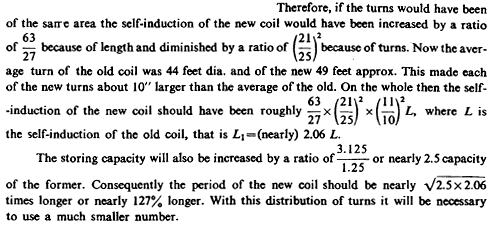
Colorado Springs
Oct. 2, 1899
As expected the coil wound before was unable to stand the strain and a different distribution of turns of the secondary was made. The ten turns nearest to the ground were left as before and the
remaining were placed one turn in each second groove making the distance between the upper turns 2 5/8" and lower ones 1". Even with this arrangement, some of the upper and also some of the lower
turns would break through.
A change was again made and only 4 of the turns — the lowest — were left 1" apart and all the others were placed in every second groove. The tests showed that the turns could now withstand the
full charge. Perhaps up to six first turns might have been left at a distance of 1" — but it was thought that the distribution was good enough as it was.
The last change reduced the number of turns to 18 (the uppermost not counted). Compared with the last form of tapering coil of 25 turns the period of the new was now approximately estimated from
rough data below:
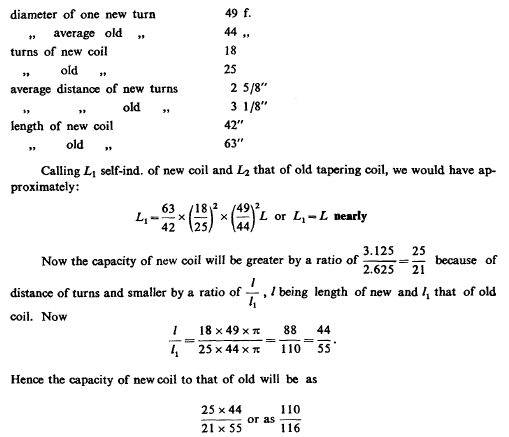
or very nearly equal.
Therefore the distribution of the turns will secure nearly the same period of vibration as in the old coil.
Colorado Springs
Oct. 3,
1899
Useful data in estimating possible errors due to the proximity of the ground or conductors or other causes.
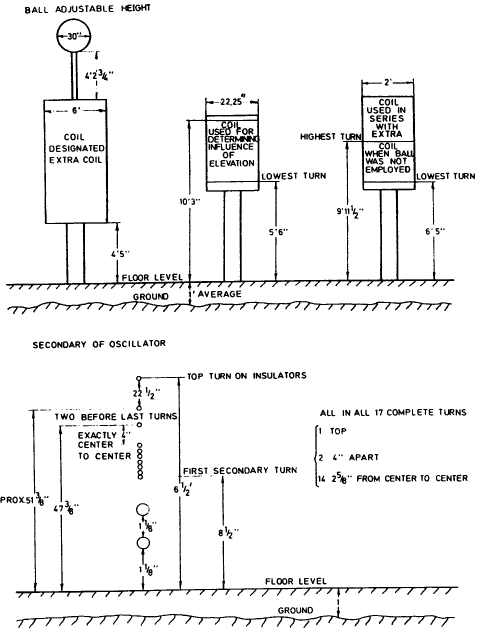
Colorado Springs
Oct. 4, 1899
Test to determine more exactly influence of elevation on capacity of an insulated body.
A coil was wound to suit best the special conditions of this test. On a drum of 2 feet and 1 1 /4" diam. were wound 400 turns, wire cord No. 20. The insulation was very thick but of small
specific inductive capacity. This wire with widely separated turns was used in order to make the capacity of the coil itself as small as possible compared with capacity of insulated body. The
latter was in this case the one sphere of 30" diam. arranged to be elevated at will to a height up to nearly 40 feet from the ground.
The wire had a diam. approx. No. 20 B. & S.=0.032" or 0.8128 mm. The circumference of wire if solid would have been about 2.4 mm. Now one turn of wire was π x 25.25" or about π x 641 mm. The
total length π x 641x 400=256,400 x π mm. Hence total surface of wire only π x 256,400x2.4=615,360 π sq.mm. or 6154π sq.cm. Now the diam. of the sphere was 30" or 76.2 cm. The surface π
d2=18,231 sq. cm. approx.
The utmost we could take would be 1/2 surface of wire, that is 3000 π sq.cm. and this would be only 1/2 of surface of sphere. But other things
considered, it would appear that the error due to electrostatic and distributed capacity of the coil itself would be small. This is however to be further investigated and allowance made for. It
would be, of course, desiderable to entirely do away with the capacity of the coil to make the results of the observations rigorously true, but this will be hardly possible.
The number of turns on the coil was selected so as to be suitable to the apparatus used normally. The total length of the coil so far as wound was 57 1/8" or 145.1 cm, diam. of drum 25.25"=64.14
cm. To calculate self-induction we have then the following data:
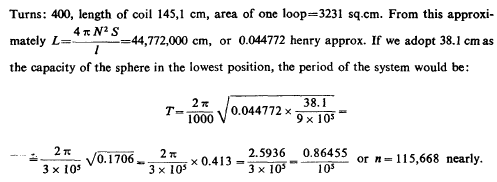
This is a vibration far too quick, in reality it will be much slower because of capacity in the coil. Diagram shown illustrates arrangement used in experiments: The coil of 400 t. was excited by secondary of oscilator, and capacity and self-induction in primary were varied until resonance of free system comprising coil of 400 t. and ball of 38.1 cm cap, was obtained. This was evident from spark length and other indications, as streamers.
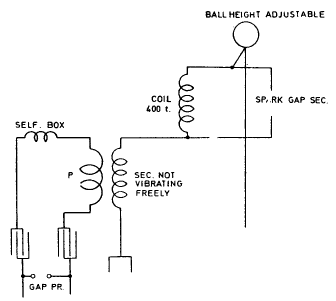
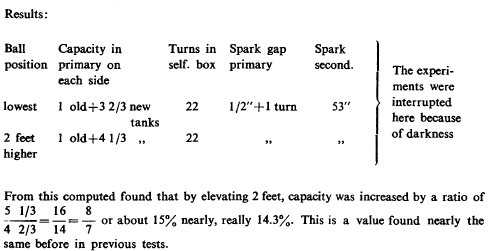
To be followed up.
Colorado Springs
Oct. 5,
1899
Test of secondary last pattern, 17 turns in all.
To ascertain the period a spark gap adjustable was used in the secondary from end to earth, as usual, and the capacity and self-ind. of primary was varied until maximum spark length in secondary
and other indications showed maximum resonant rise.
Results:

Now a ball 38.1 cm. was added on the end and placed near the earth plate at a distance of about 3 1 /2 feet but very little affecting the
vibration. This shows that distributed capacity in secondary is very large as before.
Capacity of one tank being 0.03816 mfd. Taking approx. Lp=56,400 and 13 turns box 46,800.
We have:
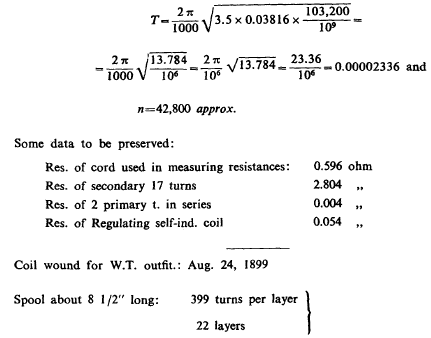
Latest secondary in receiving apparatus, No. 30 wire, 90 turns per layer, 35 layers Res. 424 ohms.
Tests showed best result with 56—68 primary turns. 62 turns, No. 20 cord, are now used. Res. of cord 0.39 ohm.
Test with special coil for determining more accurately the law of variation of capacity with elevation. The coil with 400 turns No. 20 cord was used as previously and the adjustable ball of 38.1
cm capacity. The ball was normally above the extra coil repeatedly referred to, which on account of its great internal capacity was not used. Although unconnected some error was necessarily
caused by the presence of the coil near the ball when the latter was near its lowest position.
A further error was anticipated from the influence of the roof at the points when the ball, which was being gradually lifted during the test, was nearest to it. The smallest distance or nearest
point was about 11 feet. Nevertheless some action was bound to occur although the wood is very dry here and it is proposed in later tests to eliminate these errors as much as possible.
The roof was covered with some sort of tar paper the influence of which can only be conjectured at present. The most reliable data will be those obtained with ball at the highest points when it is above all structures.
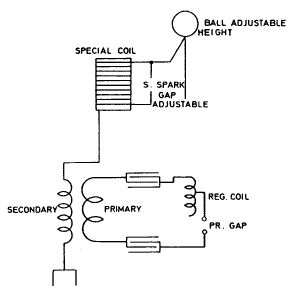
The connections used are shown in diagram. The ball was lifted by steps of one foot each and the primary self-induction and capacity was
adjusted until maximum resonant rise was observed on special coil, and adjustable secondary spark gap serving as analyzer, besides streamers which served even as a better guide. The results of
the test are shown on the following table:
Table showing results. The capacities are all reduced to the same inductance so that as the primary capacity changes, the secondary is changed in the same ratio.
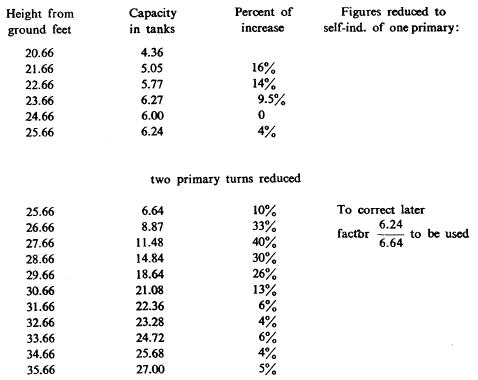
Table showing results of observations on influence of height in determining capacity of a sphere connected to the coil before described. The sphere of 38.1 cm. electrostatic capacity was gradually elevated and the period of vibration determined for every position of the sphere, by varying the capacity and self-induction of primary circuit.
As the self-inductions of both circuits remained the same the secondary capacity varied exactly as the primary.
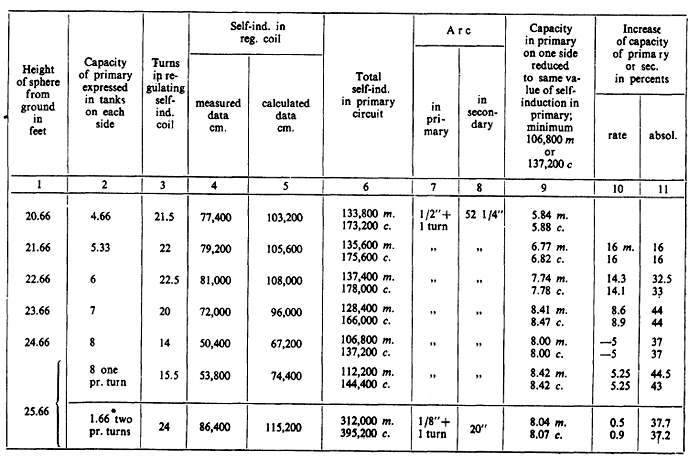
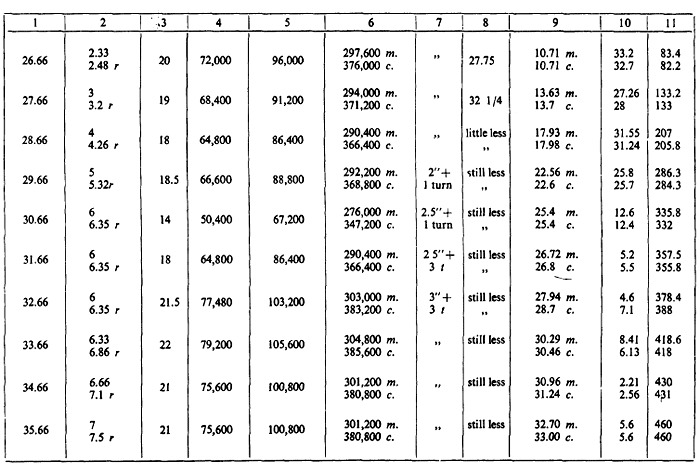
Observations:
Tuning was very sharp from line 27.66 to end. The arc in the primary was getting stronger and stronger. This probably because of lower frequency. The flaming of primary arc also because of this.
For same reasons secondary arc was getting continually weaker as the ball was elevated.
m read measured data
c read calculated data
r read reduced data.
From the sign* two primary turns were used in series as the vibration got too low and not enough primary capacity was available with one turn. This was thought preferable to tuning to harmonic. From the figures on the side of 25.66 line it will be seen that the capacity with two turns was not exactly one quarter of 8, that is 2 tanks, but less.
This was probably due to the fact that the tanks are not exactly equal and more so because when two primaries are used in multiple as one single
turn the self-induction is less than 1/4 of that of two turns in series. To reduce to same self-induction as with one turn the capacities obtained with two turns should be multiplied by
6.64/6.64.
Colorado Springs
Oct. 6,
1899
Measurement of coefficient of self-induction and mutual induction.
Secondary last form 17 turns of which total 16 turns disposed on frame described before, one turn in every second groove, one groove near the primary free. Average of readings: p=880 Voltage
across secondary E=122.5 V, I=13.8 amp.; Res. R=2.804 ohms. From this
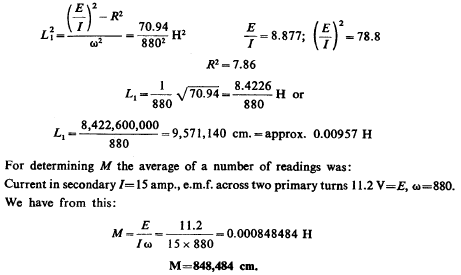
Colorado Springs
Oct. 7, 1899
The secondary was again changed by displacing the 15th and 16th turn, the rest remaining as before: namely, 14 turns, a turn in each second groove and the 15th and 16th turn each in every third
groove and the top turn on porcelain insulators as before. This changed very little the constants of the circuit.
The test was now made closed with the following results:
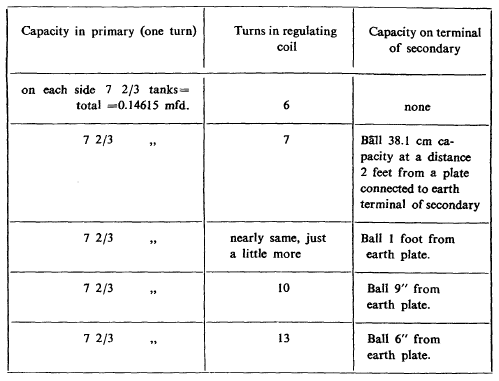
Tuning of extra coil to suit vibration of the secondary latest design, as specified on another sheet today.
An attempt was made to get the vibration of the coil with ball elevated exactly as that of the secondary. To adjust the vibration the ball was elevated to various positions and soon the
adjustment was reached.
With an elevation of 2 feet lower than the highest point (35.66 feet from the ground) — that is 33.66 feet from the ground the maximum resonant rise on coil, as evidenced by the spark, was
obtained with 7 2/3 tanks capacity on each side and 13 turns in the self-induction coil. Lowering the ball just a trifle and making capacity on each side 8 tanks the resonant maximum rise in coil
took place with 10 turns in regulating coil. This was almost exactly the vibration of the secondary as previously ascertained.
The two were now connected in series and discharges on a spark gap of something like 12 feet were obtained, although the W.T. was not strained to the utmost. When the spark wire was taken off and
ball with a rubber covered wire No. 10 specially prepared left alone, streamers formed on top of ball, but little as the wind was blowing. The ball being disconnected and rubber wire alone left,
the streamers were very fierce reacting sometimes 16—18 feet. Best results were with 6 turns in coil in the last experiments.
A more careful tuning of extra coil without ball, only rubber covered wire or cord No. 10 (which was referred to before), the tip of cable being brought out about 2 feet and inclined to
horizontal about 45°. This wire to prevent streamers was specially made and was covered with rubber. Composition Habirshaw, 40% pure Para. The tuning of the coil alone with the self-induction
coil specially wound in series, gave:

The coil used in series with the extra coil was one especially adjusted so as to give the same vibration to the system as when the extra coil
was used alone and with ball on top at highest point. The coil has 160 turns and is wound on a drum 2 feet in diam. with wire No. 10, same as used in the secondary and extra coil.
Now the secondary with a ball on the end and elevated at a height of 2.66 feet from the ground gave also exactly, with 8 tanks in primary on each side and 6 1/2 turns in regulating coil, maximum
effect. When the two were connected in series the display was magnificent, sparks flying to the ground a distance of over 16 feet. Their curved paths stretched out would be certainly 24 feet
long. This was not the maximum of the power of the apparatus as the spark in the primary could have been still lengthened without difficulty.
Colorado Springs
Oct. 8,
1899
Experimental data in connection with tuning of extra coil and secondary as recorded yesterday.

Now the length of wire in the secondary was 803 meters, namely 17 turns each of a diameter of 15 meters.
The total length of wire in the extra coil circuit was: the extra coil itself 889 meters, namely 149 turns each of diameter of 1.9 meters plus special coil inserted in series: 307 meters, namely
160 turns each of diam. of 0.61 meter.
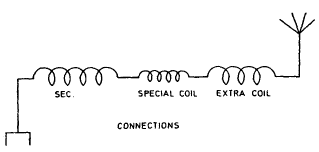
This special coil was used when the ball on top was not employed as capacity and the coil was so adjusted that the vibration was the same without the ball as with the ball and without the special coil; it being understood that the ball was at its highest position in such case. The total length of wire was therefore:

with all connections the length was increased to 2030 meters (17 meters rubber wire on top; 13 meters lower connecting wire).
Now capacity in primary was 4 tanks=4x0.03816=0.15264 mfd.
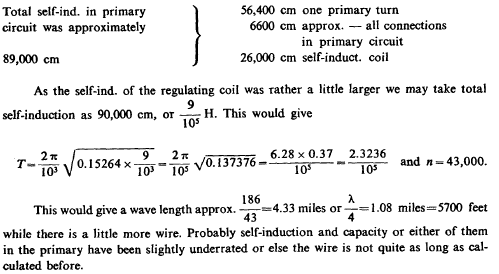
Colorado Springs
Oct. 9,
1899
Today an other effort was made to ascertain more closely rate of increase of capacity of a body with the height above the ground. The same adjustable sphere was used and to eliminate some
influences which might cause errors the special coil, which was rewound with same wire as before and had now 404 turns, the wire being wound a trifle higher, was connected to the first turn of
secondary of oscillator, that is the turn first from the ground.
This gave a small initial e.m.f. and reduced the ei rcr due to capacity very materially. (Here the distributed capacity is meant). Also, since the pressures developed were much smaller owing to small initial pressure on the special coil the streamers did not appear and did not therefore complicate the observations as in some previous cases.
The plan of connections is clear from the diagram below.
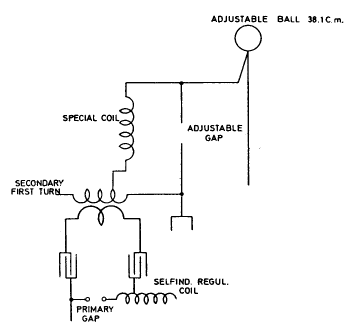
The object was specially to obtain a number of values which were as closely determined as possible and with the ball in positions entirely above the building. Only three values could be obtained owing to darkness setting in, but these seemed fairly close as the tuning was done over and over with same results.
These were as follows:
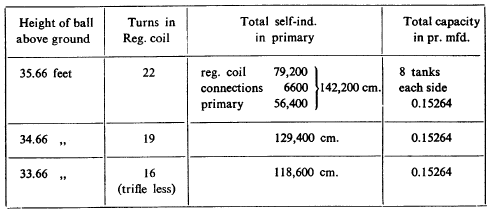
Now since the capacity in the primary was the same the capacity in the secondary varied directly as the self-induction of the primary. The above figures show that from 33.66 feet to 34.66 feet, that is an elevation of one foot, the increase was 9.1%, while for the next foot higher it was nearly 9.9% on the average, say, 9.5%. At this rate the increase of capacity of the elevated sphere with the rise from the ground would be greater than before found.
The absolute rate of increase can be approximately estimated from the period of vibration. As before found the special coil with 400 turns had a self-induction of 44,772,000 cm. Now, however, with 404 turns this would be increased about 1% so that the self-induction would now be

But to this should still be added the self-induction of one turn of the secondary and wire leading to the ball and also the wire leading from the bottom of the special coil to the first turn of the secondary. The total length of these three wires is 240 feet and this is about 12% of the total length of the wire in the special coil which is 2854 feet.
But inasmuch as the one secondary turn was very close to the primary and inasmuch as the other two wires were not coiled up, the self-induction of these wires was comparatively small, estimated a little over 200,000 cm so that the total self-induction was with fair approximation: 44,500,000 cm, or about 0,0445 henry (calculated). Now, with a ball of 38.1 cm capacity the period of secondary would have to be:

This capacity c is now the actual capacity of the sphere at an elevation above considered, that is 33.66 feet. Namely, the total capacity was that of the sphere at that elevation — that is c — plus the ideal capacity of the coil derived from the computation of the primary vibration.
This latter capacity has been called C. The inductance of the special coil being as before found, 0.0445 henry, and there being resonance under
the conditions of the experiment at the elevation, named Tp', gives the value for the secondary period.
Now at another elevation, say 34.66 feet, we shall have similarly
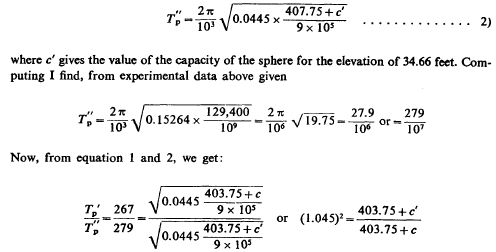
and from this: 1.092x(403.75+c)-403.75=c', but c being 38.1 we find for c'=78.75 cm, which result shows that by lifting the ball from an elevation of 33.66 feet to 34. 66 feet or one foot higher the capacity has been increased from 38.1 to 78.75 cm, or nearly 106.7%. Similarly we find the increase from 34.66 to 35.66 feet by computing the primary vibrations at these elevations.
By analogy to the previous we have
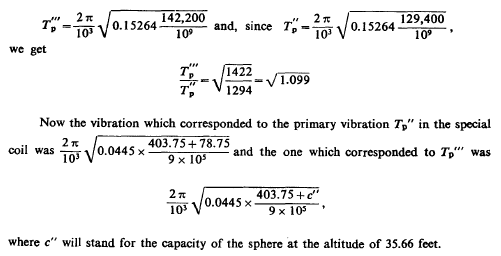
And now we have:

The value at one foot lower was, as before found 78.75 cm, therefore by lifting the sphere from 34.66 to 35.66 feet, the capacity was further increased by 126.51—78.75= =47.76 cm, or about 125%. The value which would correspond to the mean would therefore be about 116% per foot. The method followed contains still some possible errors.
One of them lies in the assumption that the capacity of the sphere was 38.1 cm at the starting point. Also there may be an error in the
estimation of self-induction of the turns of the regulating coil.
Colorado Springs
Oct.
10, 1899
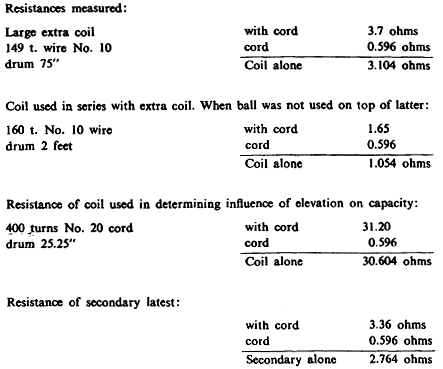
Colorado Springs
Oct. 11, 1899
Photographs of streamers were taken late last night again and at an early hour this morning under the following conditions.
First two plates exposed to ten flashes, 1/2 second duration each. These flashes issued from the tip of rubber-covered cable or wire No. 10 which was on top of the extra coil. The tip was
inclined about 45° degrees to the vertical and pointing downward. The full front view was taken. A curious observation was made.
One of the large streamers, about 22 feet long, disappeared at that length for a space of about a foot and continued again after that for a distance of about 2 feet, so that the total length of it was about 25 feet with a dark interval of one foot.
Evidently, the current passed for a distance of a foot through air or dust particles which were better conducting and the path was of a greater
section in all probability. Perhaps the air on that spot might have been electrified in such a way as to produce the phenomenon.
The next experiment was made with an exposure of two plates to about forty flashes, the view being the same as before.
After this two plates were exposed to but a single short Sash about one second, the view being still the same as before. Now a round sheet zinc disk was fastened to the tip of the wire and two
plates were again exposed, there being about twenty flashes. Next, the coil was turned and a side view taken with about forty flashes, two plates being again exposed as in all previous cases, two
cameras being used for the sake of safety.
Upon this the zinc disk was taken off and a ball of 4" diam. fastened to the tip of the No. 10 rubber-coveted wire. A long exposure of about 50
flashes was again made. The streamers were as expected a little stronger from the ball then from the point as the breaking out took place at a greater pressure. Two plates were used also in this
instance.
The next experiment consisted of taking an impression on two plates of the secondary alone in resonating condition. The phenomenon was beautiful to an extraordinary degree. Not only did the top
wire glow but from the under wire (turn next below) a steady sheet of streamers of very fine texture issued of an area which must have been many hundred square feet.
The free end of the secondary had the ball of 38.1 cm connected to it at a distance of 32" from the ground but owing to the large radius of curvature sparks did not leap from the ball to the grounded zinc plate below though the distance was small comparatively. During the experiments a short but thick stream issued from the free terminal of the extra coil which had its other end connected to the ground and was thus excited through the vibration of the secondary, having, as stated on a previous occasion, the same period of vibration.
The color of the light issuing from the secondary wires, particularly in the neighbourhood of the condensers, was remarkably blue, and should
affect the plate strongly, though the intensity was not great. The switch was thrown in fifty times, the duration being about 1/3 of one second, possibly 1/2.
The last experiment consisted of establishing the resonance of the extra coil and secondary in series connected and with the ball of 38.1 centimeter on the free end of the extra coil, the ball
being at its lowest position, 20.66 feet from the ground.
The other ball of the same size remained as before, connected to the end of the secondary where it was joined to the lower end of the extra coil. As there was great danger of inflaming the roof the power was somewhat reduced, but the display was wonderful in spite of this. This was the most significant experiment showing streamers from the ball of 38.1 cm capacity from which is evident the enormous tension, as well as the inconceivable rate at which the energy was delivered in the vibrating system.
Forty flashes were made and afterward the background was illuminated by the arc of the primary circuit to complete the picture.
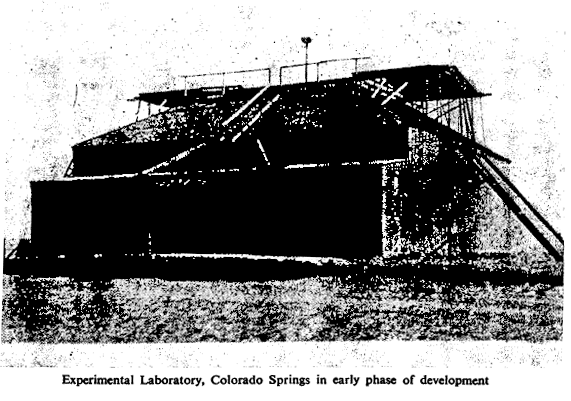
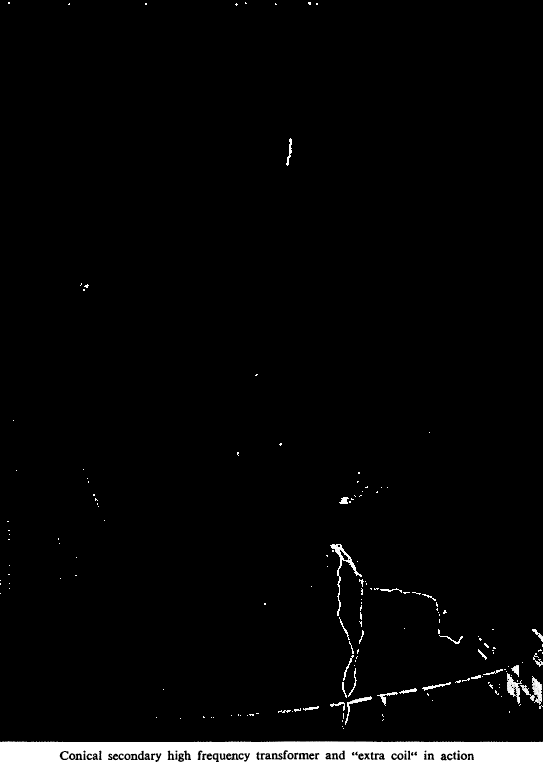
Colorado Springs
Oct.
12, 1899
Measurement of inductance of 404 turns coil used in determining influence of elevation.
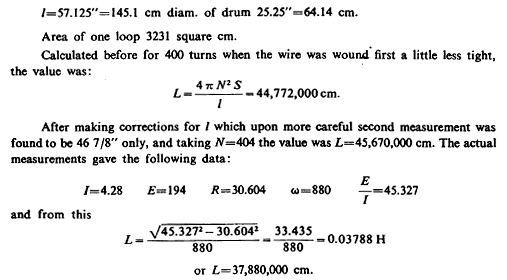
The measured value should be smaller than the calculated but not so much. The internal capacity may be responsible but very likely the current
was not quite exactly measured. Corrections to be taken after calibration.
Colorado Springs
Oct.
13, 1899
Measurement of inductances of extra coil and secondary, latest design:

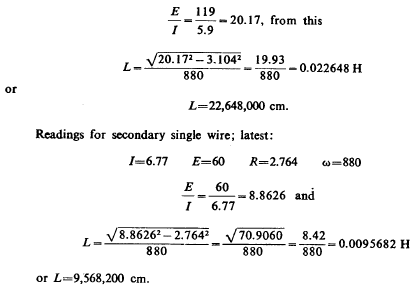
Colorado Springs
Oct. 14, 1899
Determination of the natural period of the secondary with and without capacity on free terminal, also of the extra coil and coil of 404 turns used in investigations before described.
The tuning was effected in a manner later to be more fully dwelt upon, which secured closer readings than when exciting, as in some experiments before made, by the primary current or from a turn
of the secondary of oscillator.
The excitation was effected in these tests by connecting directly one of the terminals (the lower) of the coil to be tested to one of the terminals of the primary condensers (the one connected to
the tank of W. Transformer).
The results of the test are given below:

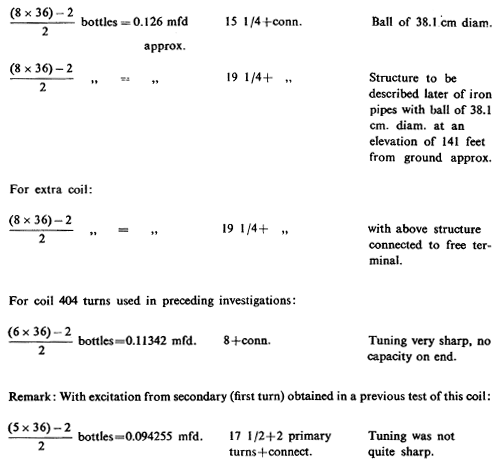
Colorado Springs
Oct. 15, 1899
Continuing the considerations made Oct. 9 on the influence of elevation upon the capacity and taking, instead of the calculated value of the self-induction of the coil used in the experiments,
the value ascertained by experiment which, with corrections for one turn secondary and connecting wires, may be put at 0.04 henry, we have, assuming now the coil to have a capacity entirely
negligible:

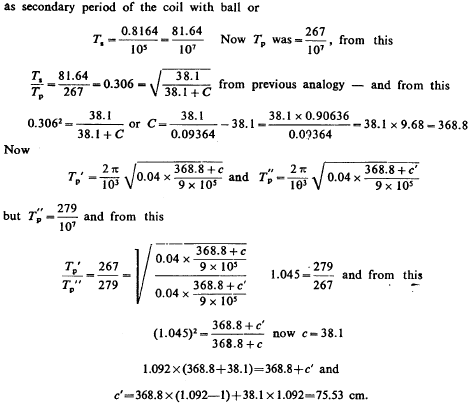
This value is but little smaller than that before found. From this result it would then appear that by lifting the sphere from 33.66 to 34.66 feet the capacity was increased from 38.1 to 75.53 cm, or approximately 98.3%, a trifle less than before found.
Next Page
Colorado Springs
Oct. 16, 1899
Inductance of secondary modified by winding another wire No. 10 in multiple with the first. All other particulars remaining:


This is closely agreeing with first measurement of a few days ago, the difference being only 1/10%.
Colorado Springs
Oct.
17, 1899
Structure for capacity of extra coil, for investigation of earth vibrations chiefly.
This structure was erected on a pole 10"xl0" square,- tapering on top. Dry fir was used because of toughness and also resinous quality. Pipes of steel of diameters 7", 6", 5", 4", 3 112", 3", and
2 1 /2" were used. They were shoved one into the other and riveted, four rivets were used on each joint, the lap being 2'.

On the top was supported a ball of 30" diam. hollow wood covered with tin foil very smoothly and the joints indented so as to have no conducting points sticking out. The joints of the pipes,
heads of rivets, etc. were all covered first with sheet rubber pure and then Nipples on top with tape, the latter being finally fastened with strong cord.
The ball was shellaced several times and finally covered with weatherproof rubber paint. The pole all along was also painted with the same paint. On the lowest end of 7" pipe a cap was screwed clearing the wood so as to make it more difficult for the streamers to get to the ground along the pole.
* To prevent lateral play 8 champagne bottles set in beams were used.

Colorado Springs
Oct. 18, 1899
For special investigations particularly to prosecute further researches on the increase of capacity with elevation, a new coil is to be constructed as nearly as possible to exact dimensions which
follow:
diam. of core 14"=35.5 cm
length of core 8x 12"=243.84 cm.
The coil is to be wound with cord No. 20, before used in the coil of 404 turns on 25.25" diam. drum.
Allowance for thickness of insulation: 0.354 cm. This makes total diameter */=35.854 cm.
For approximate value of the surface of one loop we have then S=1000 cm. sq. There should go on this length 689 turns and this would make

For the purposes contemplated this coil will be well adapted as the self-induction is large and owing to small diameter of the core and great
thickness of insulation the capacity should be comparatively small. With this coil balls of 18" and 30" diam, are to be used:
Exact diam. of core should be 14.0485"=35.6825 cm. for S=1000 cm. sq.
Colorado Springs
Oct.
19, 1899
Experimental coil before used in investigating propagation of waves through ground. This coil was rewound and presently following particulars are good.
Outside diam. of core=10 3/8"=10.375"=26.3525 cm. Turns 550, No. 18 B. & S. wax covered, thickness of one insul 14"/1000, length of core l =407/8"=40.875"=103.8225 cm.

This coil is now to be also used in investigations of the variation of capacity with. variation of Height. With ball of 18" diam., the capacity of the ball assuming to be: [18"= = 18x2.54=45.72 cm]—C=22.86 cm, the period of the system, neglecting for the present the distributed capacity of the coil, would be approximately:

or n = 223,540 per sec. approx.
In a test resonance was obtained with 42 bottles on each side of the break, that lis 21 bottles total or 0.0229 mfd capacity in the primary, which consisted of 6 turns of heavily covered wire No. 10. As it was inconvenient to measure the primary, Lp was estimated to have a self-induction of:

This is a convenient and good method but the period must be exactly ascertained. The distributed capacity can never be neglected.
Colorado Springs
Oct.
20, 1899
To ascertain the effect of internal capacity of the coil of 404 turns repeatedly referred to, which was used in the experiments on influence of elevation upon capacity of a conductor, the coil
was tuned alone with only a short length of wire attached to it. Resonance with primary was obtained with 118 bottles on each side, one primary turn.

For future reference the tanks as used are indicated in diagram. The total capacity in primary was therefore 118/2=59 bottles. Since one tank, that is 36bottles, equals 0.03816 mfd the capacity was 59/36 x 0.03816 = 0.06254 mfd.

This would suppose that the ball could have a capacity of 38.1 cm but this is physically impossible since it would have to be removed from all objects.
In reality its capacity will be always much greater and the system will vibrate much slower as a rule. In fact, the test showed that resonance was attained with the ball 10—18 feet from the ground with all bottles in and in addition 5 1 /2 turns in the self-induction box.
The tuning was naturally not sharp as the capacity was large and the maximum appeared to be with the ball 10—18 feet from the ground. To get
sharper tuning a smaller ball of 18" diameter was used and now resonance was obtained with the ball 10 feet from the ground and all bottles in and no self-induction in the regulating coil.
Colorado Springs
Oct.
21, 1899
To ascertain the value of connections in terms of turns of the regulating coil and for other purposes the coil before described, 404 turns with rubber wire attached, was tuned for three different
values of the regulating turns. The method was one frequently used in New York and is illustrated in the plan shown.

One end of the coil was connected to that end of condensers, or respectively to that end or terminal of transformer which was grounded and the rise of potential of free terminal of tuned coil was observed by an adjustable spark gap. In this manner very close adjustments are easy.
The resonating condition indicated by the longest sparks in the adjustable gap was secured with the following three values:

Now L1 and L2 should be exactly measured; resonance method will probably suit the purpose best. This is to be more rigorously carried out. In the experiments before described, for the purpose of ascertaining the influence of elevation on the capacity of a sphere, the latter was connected to the coil of 404 turns by means of a wire No. 10 heavily covered with rubber (3/8" wall).
Evidently this wire affected the period of the system and to ascertain to what extent, the wire was placed in the same position as when used in the experiments with the ball at its lowest position — 20.66 feet from the ground. The sphere was omitted but the streamers on .the end were prevented by sealing the end with wax, covering with tape and sticking the end of the wire into a glass bottle with very heavy walls.
Resonance was attained with (6 x 36)—2 bottles on each side and 21 turns in the self-induction regulating coil. This was 214 bottles on each side or 107 total. In making the test the primary turn of the oscillator, usually connecting the two coatings of the condensers on the bottom, was left off and the coatings joined by a short wire. The total self-induction in the primary circuit was therefore the 21 turns of the regulating coil plus the connections, or from previous figures 100,800+ +6600=107,400 cm.
Now in the test of Oct. 9, with the ball connected to the cable, resonance was obtained with 4.66 tanks on each side or 4.66x36=168 bottles approx. The total self-induction was 21.5 turns of regulating coil+1 turn primary + connections= 103,200+56,400+6600=166,200 cm, both values from calculated data.
Had the self induction been the same we would have had instead of 168 bottles 166,200/107,400=260 bottles. 107,400 Thus with the sphere the capacity in the vibrating secondary system was increased by 260 130 the ratio or 260/214 or 130/107.
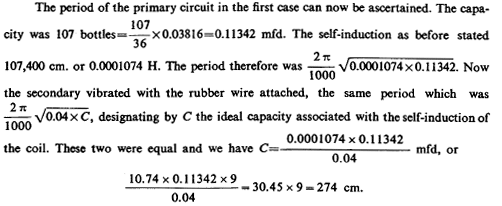
This was the capacity with the cable comprised. But before we have found the capacity of the coil alone, with no wire attached, 90 cm or nearly so.
The addition of the rubber cable made therefore a considerable difference. It would not have been so high had the streamers been entirely prevented but despite the wax and glass bottle there was a leak which had the tame effect as if the capacity had been increased. Since by adding the ball the capacity

Colorado Springs
Oct. 22, 1899
One of the upper terminals of the condenser (+ ) usually connected to the ground was joined to the lower end of the coil of 689 turns, the upper end remaining free. The ground was in this case
omitted for the purpose of securing a higher initial excitation. The maximum rise was ascertained by an adjustable spark gap as shown.
The results of the tests are given in the table below:

The spark was getting longer because the efficiency of the exciting circuit was increased, as the inductance of this circuit was increased and
capacity diminished. There were smaller frictional losses and after each break the system vibrated longer and excited the coil better.
The short stout wire was now substituted by each of the two primary turns separately and joined in multiple with the results indicated below:

In order to get useful data as to the self-induction of the connections and also of the various turns of the regulating coil which were most frequently used in the experiments, tests were made as follows. A coil still to be described, built for a special purpose, was used (689 turns, drum 14" diam., 8 feet long) and was excited from one terminal of the condensers, as indicated in the sketch below.
The coil had a definite period which was ascertained with all condensers in and the least possible self-induction; the condensers were taken out and more turns of the self-induction coil inserted until resonance was again attained. Since the period was in all instances the same the self-inductance of the circuit was thus varied inversely as the capacity.
When all self-inductance or nearly so was taken out and only the connections remained by a simple ratio between the known capacities and a known
inductance, the inductance of the connections was given, or else this quantity was ascertained from the known period which was maintained throughout the experiments (that of the coil before
referred to). The lower ends of the condensers, usually joined by the primary, were connected by a short stout conductor of inappreciable resistance and inductance.
The method used in the experiments recorded today for determining experimentally the inductance of the connections is very convenient and secures good results.

The coil used in the experiments was one of very high self-induction to make the tuning very sharp and it was wound on a drum of relatively small diameter to reduce internal distributed capacity. This likewise improves the sharpness of the adjustment. It was easy to detect variations of one sixteenth of one turn of the regulating primary coil.
From the preceding data, calling / the inductance of one turn and /, that of 22 turns, and C the capacity in the primary when 1.125 turns were used and Q that when 22 turns were employed, we have, since the period was the same:
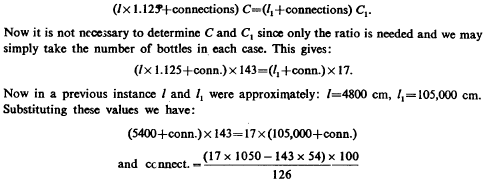
From this the inductance of the connections would be=8040 cm, or-8000 cm. approx. It would be desirable, however, to eliminate the turns of the
coil and so estimate the inductance of the connections directly.
Colorado Springs
Oct.
23, 1899
Experiments to further ascertain the influence of elevation upon capacity.
The coil referred to on a previous occasion was finished with exactly 689 turns on a drum of eight feet in length and 14" diam. The wire used was cord No. 20 as before stated so that the
approximate estimate of self-induction and other particulars holds good. The coil was set up upright outside of the building at some distance to reduce any errors due to the influence of the
woodwork. From the building extended a structure of dry pine to a height of about sixty feet from the ground.
This framework supported, on a projecting crossbeam, a pulley (wood) with cord for pulling up a ball or other object to any desired height within the limits permitted and this beam also carried on its extreme end and-close to the pulley a strong glass bottle within which was fastened a bare wire No. 10, which extented vertically downward to the top of the coil.
The bottle was an ordinary Champagne bottle, from which the wine had been poured out! and the bottom broken in. It was forced neck downward into
a hole bored into the beam and fastened besides with a cord. A tapering plug of hard wood was wedged into the neck and into this plug was fastened the wire. The bottle was finally filled with
melted wax.
The whole arrangement is illustrated in the sketch shown in which b is the bottle with wooden plug P supported on beam B also carrying pulley p, over which passes the cord for pulling up the
object, which in this case is shown as the sphere C. The spheres used where of wood and hollow and covered very smoothly with tin foil and any points of the foil were pressed in so as to be below
the surface of the sphere.
This is a necessary precaution to avoid possible losses by streamers when the sphere is charged to a high potential. It is desirable to work with strong effects as the greater these are the better the vibration can be determined, but it is necessary to carefully avoid losses and errors owing to the formation of streamers.
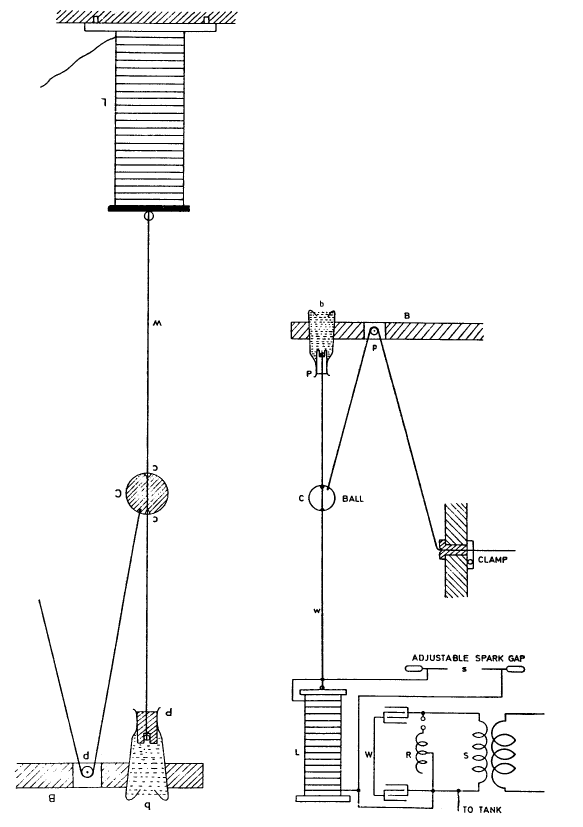
These have the effect of increasing the apparent capacity so much that a thin wire may often produce results comparable to those obtained with large capacities. The streamers, of course, cause frictional loss and thereby diminish the economy of the system and impair the quality of the results. They also cause a loss of pressure just as leaks in air on water pipes.
The ball to be tested or any other object was provided with two metallic bushings, on contacts c c, consisting of small split brass tubings which were in good connection with the conducting surface and also insured contact with wire w which at the same time served to guide the ball in its up and down movement.
To avoid losses the bushings did not project beyond the surface of the ball and for the same reason the cord was not fastened to a hook but a hole was drilled into the ball, the cord with a knot on the end was slipped in and a wooden plug driven into the hole, so that nothing was sticking out capable of giving off streamers or causing leaks into the air. In the first series of experiments a ball of 18" diameter was used. The ball was not perfectly round but the error due to a slight irregularity of shape was very small.
The plan of connections is shown in the sketch in which the same letters are used to designate the same parts of apparatus as before. The excitation of the coil was effected by connecting the lower end to one of the terminals of the condenser — the one which was connected to that end of the secondary of the 60,000 volt transformer which was in connection with the tank. The tank, as described on a previous occasion, was usually connected to the ground but in these first experiments the ground connection was omitted to secure stronger excitation.
From the terminals of the coil two thin and heavily insulated wires were led to an adjustable spark gap s which was manipulated until the maximum rise of potential on the coil was ascertained. The two sets of condensers were joined by a stout short wire W of inappreciable self-induction and resistance and the inductance of the exciting circuit was varied by inserting more or fewer of the turns of the regulating coil R Into the circuit through which the condensers were periodically discharged.
The wires leading from the coil to the adjustable spark gap s were, as before remarked, very thin, as short as it was practicable to make them and heavily insulated. By observing these precautions the error due to the capacity of these wires themselves was reduced to a minimum, also the loss owing to a possible formation of streamers. To reduce the capacity the wires were led far apart and then brought in line to the spark gap.
The lower wire, which was connected to a point of comparatively low potential was of little consequence but on the top wire these precautions were imperative. The procedure was as follows: first the period of the coil L and capacity attached to the free terminal was ascertained by varying the capacity or self-induction, or both, of the primary or exciting circuit until resonance was reached which was evident from the maximum rise of potential.
When the period had thus been determined with the capacity, say a sphere, in one position, the position of the body of capacity was varied by shifting it to another place along the wire w and the adjustment of the primary circuit was again effected until resonance was reached, generally by simply varying the length of wire of the regulating coil included in the primary circuit. Now as the self-induction of the coil L remained the same through all experiments, the apparent capacity could be easily determined from the self-induction and the known period of the primary or exciting circuit.
By keeping the capacity in the primary circuit the same or, eventually, (he self-induction, the procedure was simplified and the capacity in the
system including coil L was then at once given by a simple ratio, as in some cases previously described. It was preferable to vary the self-induction as the change of this element could be
effected continuously and not step by step, as was the case with the capacity.
The apparatus being arranged as stated, the lowest position of the ball of 18" diam., which was first used, was 9' 5" from center of ball to ground and the highest 58' 9".
To ascertain the period of the system L the vertical wire was first disconnected and only the spark wires left on, then the vertical wire was connected and the period again determined by
adjusting the primary circuit, then the ball was placed in its lowest position and finally readings were taken with the ball at various heights up to the maximum elevation.
The results condensed were as follows:
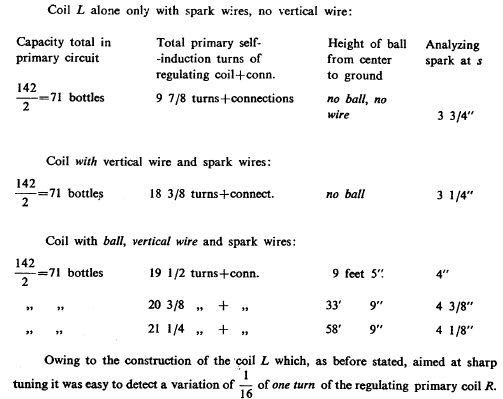
It was desirable to take some readings with all the bottles in and the results were nearly the same and could still be read off with fair
exactness, although the variation on the regulating coil R was reduced to one half, the capacity in the primary being just double that used in the experiments the results of which were just
given.
The readings with all the condensers were as follows:

Note to above experiments: The vibration of the coil L with vertical wire and spark wires was found to be in resonance with the primary in another series of observations with
142 bottles 18 3/4 turns+connections
whereas before it was found to be so with 18 3/8 turns. When the different value.18 3/4 turns was observed the wind was blowing hard and it
would seem as if this would-have had the effect of increasing the apparent capacity of the aerial vertical conductor. This is to be followed up.
The experiments seemed to demonstrate clearly that the augmentation of the capacity as the ball was elevated was in a simple proportion to the height, for at the middle position the value found
was very nearly the arithmetic mean of the values in the extreme positions.
Colorado Springs
Oct.
24, 1899
Tests continued on the effect of elevation upon the capacity of a body connected to earth. ~~ The same coil was used as in the tests just before recorded, but the ball of 18" diam. was
substituted for by one of 30" diam. These readings were in all probability closer as an improvement in the procedure was made.
The results were as follows:


Note: After these readings had been taken it was found that the ball sliding on the vertical wire did not make a good contact. This might have
modified the results slightly.
Colorado Springs
Oct.
25, 1899
Experiments on influence of elevation upon capacity of conductor connected to earth continued:
This time simply a wire No. 10 extending vertically in the continuation of the axis of the coil was used. The coil was the same as before, 689 turns No. 20 cord on drum of 14" diameter. 36 feet
of wire were first taken and after each reading 3 feet were cut off. Each time resonance with the primary was attained and the constants of the primary circuit noted, this giving the necessary
data for the determination of the capacity of the vertical wire.
The results are indicated below:

These readings are approximate.
Colorado Springs
Oct. 26, 1899
Measurement of inductance of 689 turn coil used in investigations on influence of elevation upon the capacity of a conductor.
Readings were as follows:

This is a value slightly smaller than that calculated before. Readings were also taken with small dynamometer. This slightly damaged. The readings are to be revised upon restandardizing.

Note: This value is decidedly too low owing to dynamometer indicating too large a current. Possibly during the test ω had changed.
Colorado Springs
Oct.
27, 1899
Test of condensers some of which were recently refilled. The corrections for capacity to be applied to the work of about two weeks ago.
Readings with 7 cells battery showed for one half

The difference between the two sets is probably due to different heights of solution in the tanks or bottles. In these measurements there were
two bottles less on each side in the central tanks.
Taking the above data, the total number of bottles when all were in quantity was (16x36)—4=576—4=572 bottles. 104
The capacity was 104/101 x 0.5=0.515 mfd approx. This would give

Colorado Springs
Oct. 28, 1899
Referring to the preceding results the period of the excited system without the vertical wire was as follows:

Now calling C the capacity of the excited system with only the spark" wires, L the self-induction of the excited coil, before found to be L=0.024 H, we have for the period of the excited system:

Calling presently C1 the capacity of the excited system when the vertical wire was attached, we have by similar reasoning from


The calculated value is a little larger but not much, well within the errors of the adjustment and determination of the quantities by
experiment.
Continuing we see that when the ball was at its lowest position the period of the primary was as follows:

The ball at the lowest position effectively contributed only
C'— C1 = 163.66—155.76=7.90 cm
but this low value was probably due to the fact that the vertical wire extended above.
Calculating similarly the value of C", that is the capacity of the excited system when the ball was highest:

Colorado Springs
Oct. 29, 1899
Experiments with coil 689 turns on drum 14" diam. were again continued to further study the influence of elevation upon capacity.
The same arrangement was used which was described on a previous occasion with vertical wire and ball 30" diam. The excitation of the coil was effected by connecting it to one of the terminals of
the condensers, that which was joined to the terminal of the Westinghouse Transformer which was in connection with the tank — but the connection of the latter to the ground was not made directly
but through a spark gap 1 /8 " long.
The spark wires leading to the spark gap, serving to observe resonant rise, were No. 26 gutta-percha coated and each about 25 feet long: It was really only the upper wire leading from the free
terminal which was of importance to consider. The vibration of the coil was first ascertained, nothing except the spark wires being attached. Next a sphere of 30" diam., the tin foil of which was
cut through with a sharp knife to prevent formation of eddy currents, was connected to the top of the coil and the vibration again determined.
Then the vertical wire was put on and the sphere taken off. After determining the vibration with the vertical wire the sphere was slipped on the same and readings taken with the sphere at different heights. The results were as follows:
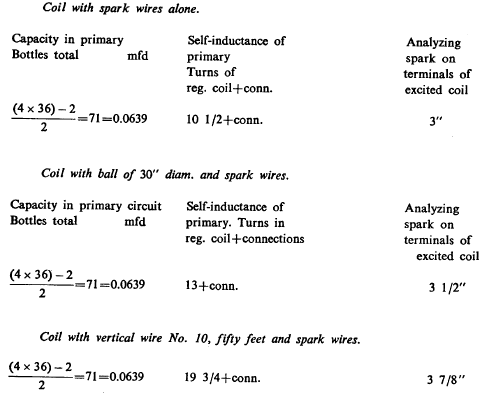
Readings with ball of 30" diam., vertical wire and spark wires connected to coil.

In these experiments the excitation of the coil was varied by adjusting the small spark gap separating one terminal of the Westinghouse transformer from the ground. The tuning was not very sharp as the ball was large and the magnifying factor of the coil rather small.
Taking n approx. 60,000 we have p=360,000 approx., R=28.3, L=0.024 we have for pL/R value  . Not so small after all. It was desirable to take some readings with the self-induction in the
primary remaining the same, the capacity only being varied.
. Not so small after all. It was desirable to take some readings with the self-induction in the
primary remaining the same, the capacity only being varied.
Following results were obtained:

These data are to be worked out.
Colorado Springs
Oct.
30, 1899
Measurement of Inductances
The primary of the oscillator, regulating coil and connections to spark gaps and condensers as generally used were joined in series, the gaps and condensers being bridged y short pieces of wire
No. 2 of inappreciable resistance. The object was to determine again: le inductance of the primary turns of the oscillator, of the regulating coil for the various turns as employed and also of
the connections. The two primary turns were joined in series and readings taken across both to get better values.
The generator, a 1500 light machine smooth armature Westinghouse type, was specially run, the speed being kept constant. The frequency was determined as before by taking le speed of synchronous
motor running without any load and with strong excitation of field. There was no slip under these conditions as frequently ascertained.
The average speed was very closely 2070 per minute on a motor which was a 4-pole, this giving 8280 cycles per minute or 138 per second. From
which ω=867.
The connections as used are shown in diagram below:
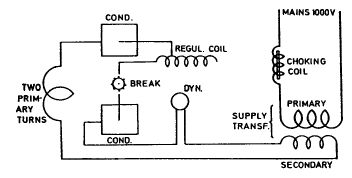
The connections were all left exactly as used generally with the exception that, as before stated, le gaps and condensers were ridged by short
pieces of wire No. 2.
Readings for: two primary turns, regulating coil 23.5 turns and all connections in series:
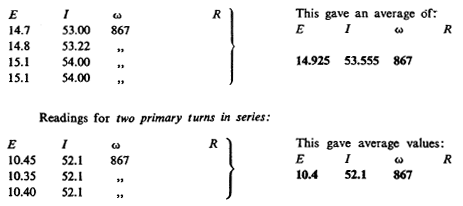
Readings were also taken across each one of the primary turns, the e.m.f. of course being exactly one half but the e.m.f. across the upper turn was slightly greater, probably because of the greater distance from the ground, possibly because of being nearer to the open secondary.
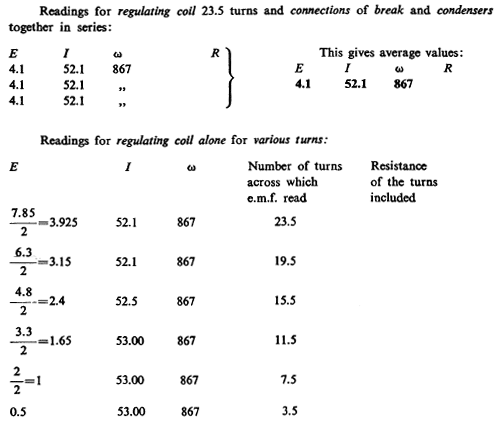
To get better readings for the separate turns of the regulating coil the voltage, was taken again as first across the whole: 2 primary turns, connections and regulating coil all in series and the turns of the latter were then varied, readings being taken for each case. The results are indicated below:

To facilitate estimation of the inductance of the various turns the readings were reduced to the same value of current and are as follows:
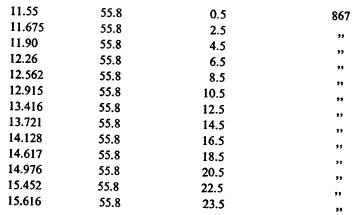
Colorado Springs
Oct. 31, 1899
Measurement of inductances: New coil for further investigating effect of altitude upon capacity of body connected to earth.
The drum of 14" diam. and 8 feet long was again used, the cord No. 20 being taken off and wire No. 10 rubber- covered used instead. Most of the data from before remained, only the number of turns
was reduced from 689 to 346.
The readings of e.m.f., current and frequency were as follows:
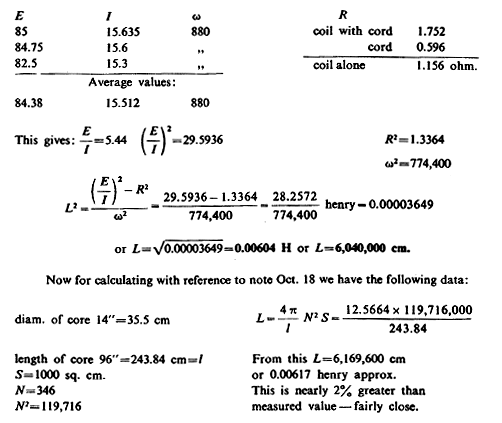
 Inventions & Experiments
of Nikola Tesla
Inventions & Experiments
of Nikola Tesla